The Five Kinds of Truth
Personal truth
We are all familiar with our own conception of what is correct, our opinion. This is based on our education and nurturing and doesn’t necessarily have anything to do with external reality. The relationship between an internal personal truth and the external reality varies from person to person and from culture to culture on a continuum from very strong connections to reality to very weak or even no connections to reality. Nonetheless, a personal truth is important, if only as a report about what our body, heart, head, mind, spirit, or dreams currently reports to our self as a whole. During the process of becoming an adult, of going through the learning cycles of life, most of us learn that sometimes another person’s personal truth about a shared event might not be the same as our own. Sometimes we discover that it is quite possible for one person to hold two conflicting truths at the same time. Who hasn’t encountered a difference between what the heart says and what the head says? “I love X, but I cannot live with X.” Both might well be true and some other aspect of the self has to figure out how to reconcile them.
Factual truth
Factual truths are external measurable facts that everyone trained in the same measuring technology will agree is an accurate report about some aspect of external reality. Such as, “The diameter of this tree is 20 inches.” As long as a statement of factual truth is precise enough, it in fact helps us in accomplishing various tasks as individuals or communities. Factual truths are the backbone of how we deal with our physical environment. Given the diameter of the tree, we can determine whether or not it might be able to yield the size lumber we need — after we assemble the other factual truths about the matter at hand, such as how straight the trunk is and what species of tree this is and so forth.
Realistic truth
Realistic truth comes in several flavors: Cultural, testimonial and interactive. Cultural truths define things like beautiful and ugly, good and bad. Testimonial truths are reports by a person about what they believe are factual truths about something they witnessed. Interactive or social truths are the statements made within a group of people at a specific time and place, usually to describe something in a blend of (collective) personal truths and factual truths. “Everyone had a good time at the company party.”
Useful Truth
Useful truths are realistic truths that are used when doing or making something, usually shared by a group of people. One group of mothers might smile at how a child makes a mess — the useful truth is the child had fun. A different group of mothers might frown and chew said child out because their useful truth was that the child made a mess. Useful truths with a very large amount of personal truth and very little realistic truth are often very harmful to persons not in the group that shares the truth. When useful truth has a fair amount of pure truth along with a few bits of factual truth, then it can become the realistic truth. It used to be a standard part of education — rhetoric, the skill of convincing others.
Pure truth
Pure truth is a truth that has no connection whatsoever with reality. “1 + 1 = 2” is a pure truth. There are no assumptions about any of those “words” other than their mathematical properties; there are no context dependent meanings or connotations; no external facts required. Pure truth has no relationship to reality other than whatever relationship statements a person agrees are valid relationships — such as agreeing that two oranges plus two apples together make 4 fruits. There are a whole host of supporting assumptions that support the pure truth of 2 + 2 = 4 when applied to 2x +2y = 4z. Formal logic is also a pure truth phenomena — if you buy into the meanings of “and” and “or” and the basic syllogistic truth table. The pure truths of numbers and formal logic provide a means of making useful truth from factual truth. This is how we get the useful truths of science and technology.
